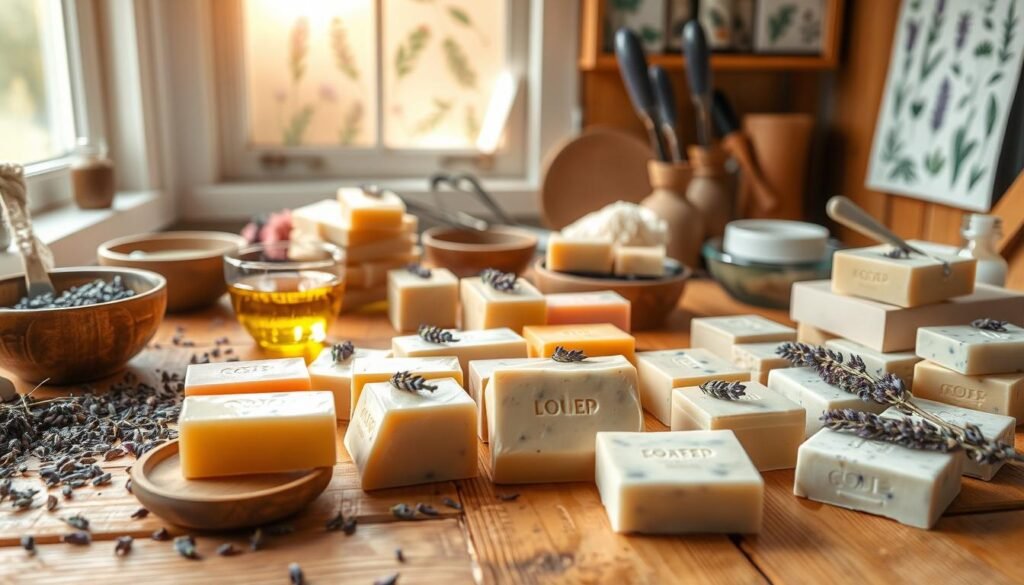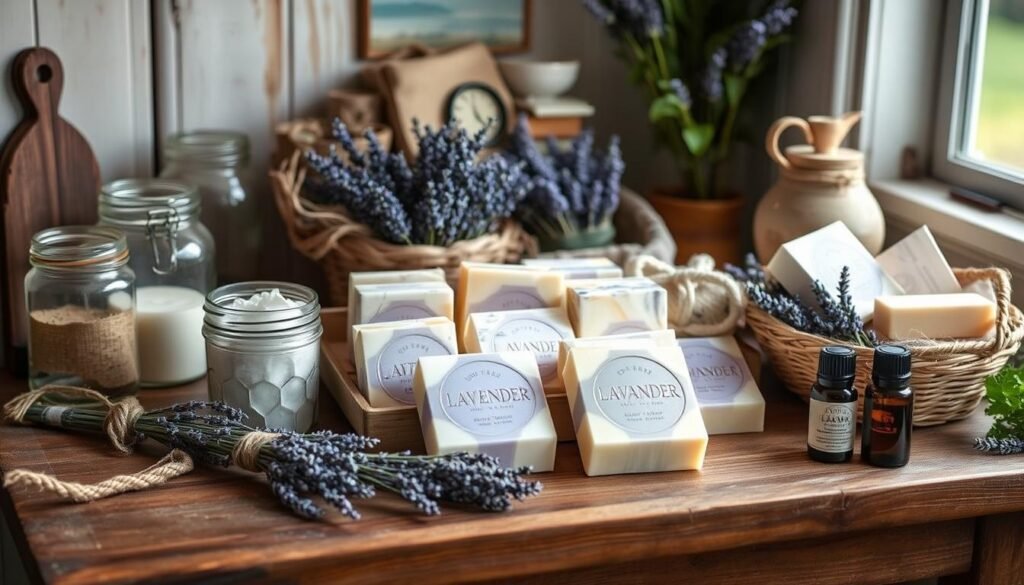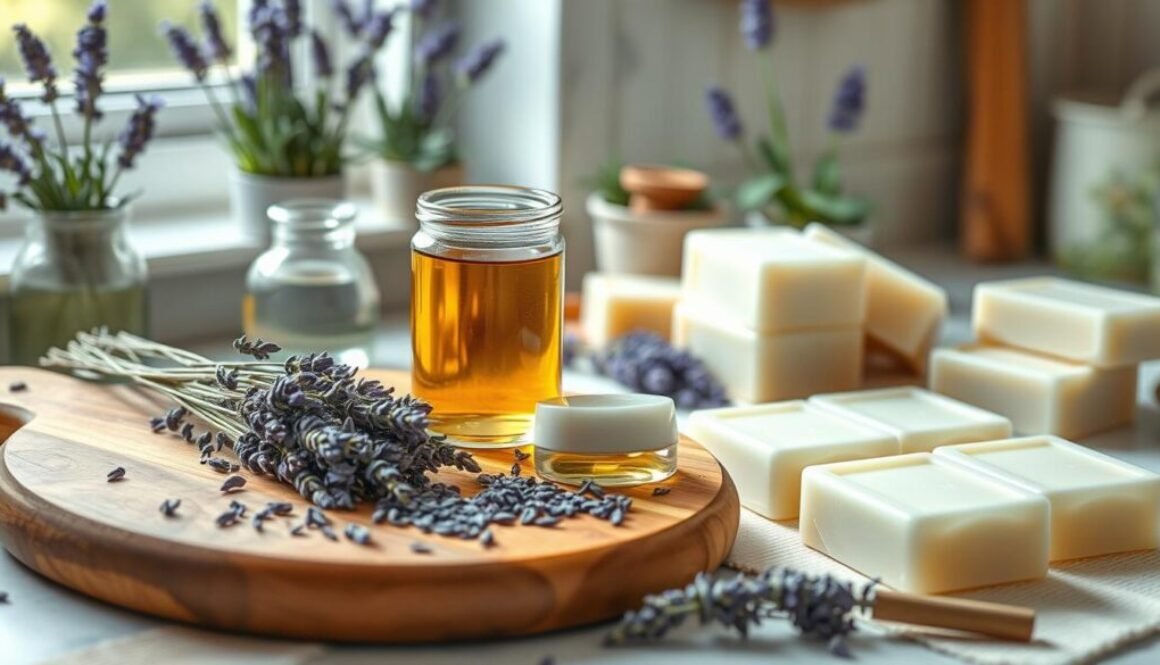DIY Lavender Soap-Making: Easy Natural Skincare Guide
Ever thought about making your own skincare at home? DIY lavender soap-making is a great way to start. It’s fun and good for your skin. We’ll show you how to make your own soap with lavender essential oil.
This guide is for everyone, from beginners to experts. You’ll learn about the tools you need and how to use them. It’s a journey to making your own soap at home.
Key Takeaways
- DIY lavender soap-making enhances your skincare routine with natural ingredients.
- Lavender essential oil provides calming and therapeutic benefits for the skin.
- Crafting your own soap can be a fun and rewarding home project.
- Essential supplies and tools are easy to source and often budget-friendly.
- Handmade soap makes for unique and thoughtful gifts.
Introduction to Lavender Soap-Making
Lavender soap-making is a fun way to make homemade beauty products that care for your skin and soul. It’s a DIY skincare project that lets you make natural soap with lavender’s calming scent. This activity is not just therapeutic but also adds a special touch to your self-care routine.
Lavender in soap is more than just a smell; it’s about using lavender’s calming effects. It helps reduce stress and brings peace, making it great for natural soap. Making lavender soap at home is a creative journey that fits well with a natural lifestyle. It turns simple bath times into special moments.
If you love DIY skincare, lavender soap-making is perfect for you. It mixes creativity, aromatherapy, and beauty. Making your own lavender soap is a great way to add something new to your beauty routine, whether for yourself or as gifts.
Benefits of Lavender for Skin Care
Lavender is known for its amazing lavender benefits that go beyond its scent. It has strong antibacterial and anti-inflammatory effects. This makes it great for skin care products.
Using lavender regularly can calm irritated skin, help it heal, and make it look fresh. It’s a key ingredient in many aromatherapy soap products.
The soothing smell of lavender is a big reason it’s loved in aromatherapy soap. It not only cleanses but also relaxes you. Adding eucalyptus oil to the mix is a smart move. It brings more antibacterial power and can help with breathing when you smell it.
Research shows lavender can lift your mood and lower stress. Adding it to your skin care routine makes it more than just a clean-up. It’s a way to care for your skin and calm your mind. Lavender soap does more than clean; it nourishes your skin for a healthier glow.
Supplies You Need for DIY Lavender Soap-Making
Starting your cold process soap-making journey means picking the right supplies. You’ll need essential ingredients and soap crafting tools. This guide will help you choose what you need to make your own lavender soap.
Essential Ingredients for Cold Process Soap-Making
Choosing the right ingredients is key for making herbal soap. Here are the must-haves:
- Oils: Olive oil, coconut oil, and palm oil are great for moisturizing.
- Lye: Sodium hydroxide is needed for turning oils into soap.
- Water: Use purified water to mix with lye.
- Lavender essential oil: It adds a nice scent and calming effects.
Tools Required for Soap Crafting
Having the right tools makes soap-making better. Here’s what you’ll need:
- Digital scale: Accurate for measuring oils and lye.
- Mixing bowls: Stainless steel or heat-proof glass bowls work best.
- Stick blender: Blends ingredients well and speeds up the process.
- Soap molds: Choose from various shapes and sizes; silicone molds are easy to use.
Choosing the Right Lavender Essential Oil
Finding the perfect lavender essential oil is key to a great DIY soap-making experience. Purity is crucial, as it affects your product’s quality. High-quality oils come from Lavandula angustifolia and Lavandula intermedia species. These have different scents and health benefits, with angustifolia known for its calming effects.
Choose oils that are 100% pure, without fillers or synthetic stuff. Look for organic or therapeutic grade labels for the best benefits. A good supplier can greatly improve your soap’s quality.
Think about what each type of lavender oil offers. For example, Lavandula angustifolia helps with sleep and relaxation. Lavandula intermedia has a stronger scent, perfect for soap. The right lavender oil makes your soap smell great and feel luxurious on the skin.
Step-by-Step Guide to Making Lavender Soap
Making lavender soap at home is a fun and rewarding hobby. This guide will walk you through the steps, from setting up your workspace to pouring the soap. You’ll enjoy the process of creating your own artisan soap.
Preparing the Workspace
First, make sure your workspace is clean and organized. Collect all the tools and supplies you need. Cover your surfaces with protective materials to avoid spills. A tidy workspace helps you focus and avoid distractions.
Melting and Mixing Ingredients
Start by melting the soap base. Pick a high-quality melt-and-pour soap base, like glycerin or shea butter. Cut it into small cubes for faster melting. Heat it gently in the microwave or a double boiler until it’s fully melted.
Next, add your lavender essential oil and any colorants or extra ingredients. This step makes your soap look and smell great.
Pouring and Setting the Soap
Now, it’s time to pour the soap mixture into molds. Fill them to the level you want. Let the soap cool and set for a few hours.
Once it’s hard, take it out of the molds. You’ll see your beautiful soap. This is the exciting part of making your own soap!
| Step | Description |
|---|---|
| 1 | Prepare your workspace and gather all necessary supplies. |
| 2 | Cut the soap base into cubes for efficient melting. |
| 3 | Melt the soap base using a microwave or double boiler. |
| 4 | Mix in lavender essential oil and any desired additives. |
| 5 | Pour the mixture into soap molds. |
| 6 | Let the soap cool and set before removing from molds. |
Tips for Successful Handmade Soap
Mastering a few key tips can make your soap-making journey better. Understanding the concept of trace is crucial. This is when your soap mix is like a light pudding. At this point, you can add colors or essential oils to make your soap special.
Keeping the temperature right is also important. If it’s too hot or cold, your soap might not turn out right. Watch your mixtures closely for the best results.

Curing time is key for great soap. Letting your soap cure for four to six weeks makes it better. It improves texture and makes it last longer. Be patient for the best results.
To avoid mistakes, double-check your lye measurement. The wrong ratio can make your soap too harsh. Also, make sure your molds fit your mix well. By focusing on these tips, you’ll get better at making soap.
- Double-check all measurements before starting.
- Choose high-quality ingredients for the best outcome.
- Experiment with small batches to practice artisan soap techniques.
- Keep detailed notes on your processes and outcomes.
| Tip | Description |
|---|---|
| Trace | Monitor how thick the mixture is before adding any extra ingredients. |
| Temperature | Ensure both lye and oils are at a similar temperature for proper mixing. |
| Curing | Allow soap to cure for at least 4-6 weeks for optimal texture and longevity. |
| Lye Accuracy | Measure lye accurately to prevent harsh soap reactions. |
| Mold Selection | Use appropriate molds to avoid difficulties in unmolding. |
These tips will help you make great handmade soap. Keep trying new things and you’ll get better at it. Enjoy the creative process of making soap.
Exploring Variations: Herbal Soap Infusions
Getting creative with soap crafting lets you make unique lavender soaps. Adding different herbal infusions can make your soaps more soothing and scented. It’s a fun way to personalize your soap-making.
Try adding chamomile for calmness or eucalyptus for a fresh scent. These soap variations bring new life to your homemade soaps. Here are some ideas:
- Chamomile Infusion: Chamomile adds a calming touch to your lavender soap.
- Eucalyptus Oil: It brings a refreshing scent and wellness benefits.
- Mint Leaves: Mint adds an energizing aroma and a cool skin feel.
- Calendula Petals: These petals are not only pretty but also anti-inflammatory.
Trying out these variations boosts your soap crafting creativity. You can make each batch just right for you or your skin’s needs. Keep track of your recipes to make them again later.
| Herbal Infusion | Benefits | Recommended Amount |
|---|---|---|
| Chamomile | Calming and soothing | 1-2 oz |
| Eucalyptus | Refreshing and invigorating | 1-2 oz |
| Mint | Energizing and cooling | 1-2 oz |
| Calendula | Anti-inflammatory and healing | 1-2 oz |
Storage and Usage of Your Artisan Soap
Storing your homemade lavender soap right is key to keeping it fresh and effective. Soap storage tips can make your artisan soap last longer. Keep it in a cool, dry spot, away from sunlight and moisture. A soap dish with drainage helps prevent sogginess, keeping your soap in better shape.
When using your artisan soap, be gentle. Use a soft washcloth for better lather and skin care. Shorter showers or baths also help your soap last longer. Always store it in a well-drained area after use to avoid water damage.
To care for your DIY soap, wrap it in breathable materials like muslin or wax paper. This keeps the scent and freshness in. Avoid plastic wrap, as it can trap moisture and cause mold. By following these tips, you can enjoy your handmade lavender soap for a long time.

| Storage Method | Description | Benefits |
|---|---|---|
| Cool, Dry Place | Store soap away from heat and humidity | Prevents melting and degradation |
| Soap Dish with Drainage | Use a dish that allows water to escape | Keeps soap dry post-use |
| Breathable Wrap | Wrap soap in muslin or wax paper | Maintains scent and freshness |
| Regular Usage | Use soap consistently to enjoy benefits | Ensures even wear and prolongs shelf life |
Gift Ideas Using Your Lavender Soap
Making personalized skincare gifts with your DIY lavender soap is fun. There are many ways to give lavender soap as a thoughtful gift. Here are some lavender soap gift ideas that make any occasion special.
- Gift Sets: Combine your lavender soap with nice bath accessories like loofahs and washcloths. Put them in a pretty basket for a great look.
- Wedding Favors: Small bars of lavender soap make cute wedding favors. Add the couple’s names and wedding date to the packaging for a personal touch.
- Holiday Presents: Wrap your lavender soaps in holiday paper or boxes. Include a heartfelt note to make your DIY gifts unforgettable.
- Care Packages: Put together care packages with your lavender soap, bath salts, scrubs, and candles. They promote relaxation and self-care.
Remember to highlight the quality and uniqueness of your personalized skincare gifts. The care you put into making the soap and the thought in how you present it will leave a lasting impression.
Conclusion
DIY lavender soap-making is a fun way to get creative and improve your health and skin care. It’s easy to do, so anyone can try it, no matter their experience. Using natural ingredients means you’re making healthier soaps and taking care of your skin the natural way.
Making your own soap is rewarding and brings happiness. You can try new things and add your special touch. Plus, lavender has calming effects that make the process even more enjoyable. It’s a great way to connect with others who love making soap.
So, get your materials ready and have a craft party with friends. Making these soaps can make you feel good and improve your skincare. Enjoy the process and the results!
FAQ
What are the benefits of using lavender soap for my skin?
Lavender soap is great for your skin. It fights bacteria and reduces inflammation. It can calm irritated skin and help it heal.
Its soothing scent also lifts your mood. Plus, lavender helps reduce stress, making it perfect for self-care.
What ingredients do I need to make lavender soap?
To make lavender soap, you need olive oil, coconut oil, and palm oil. You also need lye, water, and lavender essential oil. Each plays a key role in making the soap.
How do I ensure that I am using a high-quality lavender essential oil?
Choose lavender essential oil from trusted suppliers. Look for pure oils from reputable sources. Different types, like Lavandula angustifolia, offer unique scents and benefits.
Always check the quality label to get the best oil for your soap.
Is cold process soap-making safe for beginners?
Yes, cold process soap-making is safe for beginners. Just follow safety tips like wearing gloves and goggles. Make sure your workspace is ready and you know the steps.
What tips can help improve my soap-making technique?
To make great handmade soap, understand trace and control temperature. Follow curing times and measure lye accurately. Also, prepare your molds well to avoid mistakes.
Can I customize my lavender soap with other ingredients?
Yes, you can! Add herbs and essential oils to make your soap unique. Try chamomile for calmness or eucalyptus for a fresh scent. Personalizing your soap makes it special.
How should I store my homemade lavender soap?
Store your soap in a cool, dry place to keep it fresh. Use wax paper or a breathable container to preserve its quality. This helps it last longer.
What are some creative gift ideas using my lavender soap?
DIY lavender soap is a great gift! Create gift sets with bath salts or scrubs. Package your soap nicely for weddings, holidays, or as personal gifts.
